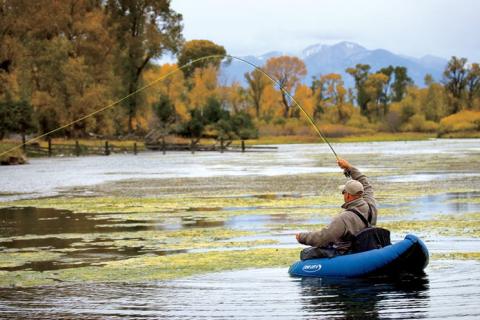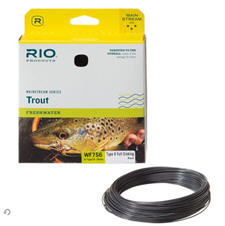
If you are new to fly fishing then you are probably overwhelmed with the amount of new tackle and terms you need to understand just to get started. Fly fishing, like most other types of fishing, really is quite simple once you get past the learning-the-gear phase. To start, fly anglers need to understand that fly fishing requires a balanced system. The fly rod weight and line weight need to be matched. Each rod is designed to handle only a certain weight of fishing line and if you exceed the recommendation then your casting distance and efficiency will suffer. If you use too light a line for the fly rod you are using then your accuracy will be affected. Just like your fly rod your fly fishing line weight should also be selected based on the fish you want to catch. The chart below is a simple breakdown of what fly lines work best for each type of fish.
![]() Tip: New to fly fishing? Check out A Simple Guide to Choosing Your First Fly Fishing Outfit
Tip: New to fly fishing? Check out A Simple Guide to Choosing Your First Fly Fishing Outfit
| Line Weight | Type of Fish Species |
| Fly Line Weight 1-3 | Panfish, Crappies and Small Trout |
| Fly Line Weight 4 | Large Trout |
| Fly Line Weight 5 | Large Trout, Small Bass and Small Pike |
| Fly Line Weight 6 | Walleye, Small Bass and Small Pike |
| Fly Line Weight 7 | Bass, Steelhead and Pike |
| Fly Line Weight 8-12 | Satlwater and Salmon Species, Musky and Large Pike |
 |
| White River Fly Shop Classic Small Stream Fly Line |
Fly line density is another key concept that fly anglers must wrap their minds around when looking into purchasing a fly line. The density of a fly line determines what is going to happen when the line hits the water (sink, float or suspend). With this in mind, fly lines get divided into separate classes bases on these characteristics. The bullet points below describe the three basic densities of lines and there respected uses.
- Floating (F) lines: Your versatile go to lines in fly fishing. Floating fly lines such as those by White River Fly Shop can be adapted to fish almost any situation. If you are new to fly fishing chances are you going to need to start with a floating line due to their ease of use. These lines like there name depicts are designed to float on the water's surface. Floating lines are made for dry flies, but they can be weighted to fish wet flies, nymphs and streamers.
- Intermediate (I) lines: A little denser than floating lines and have enough body to sink slowly and fish flies just below the water's surface. Intermediate fly lines like the Rio InTouch Outbound Short Intermediate excel in shallow, weedy or sunken structure lakes where you need to get down in the water column but not too deep.
- Sinking (S) lines: Are very dense and sink at a fast rate. Sinking fly lines are designed for deep lakes or fast-flowing rivers. These lines are used most successfully with nymphs and large streamer patterns.
 |
| All--Purpose Floating fly line can be adapted to fish almost any type of species. |
Along with fly line density, fly anglers also need to think about how the different types of fly line taper designs will impact fishing. Basically there are four different tapers that available: WF, DT, L and ST.
Weight forward tapers (WF) are the most popular taper used by anglers. The weight forward terminology refers to a fly line that is built with additional weight and body in the first 10 yards of fly line. The rest of the fly line is subsequently uniform thickness and weight. This special design (the weight of the line forward) allows the fly line to cast smoother, father and with better presentation. Weight forward lines are great in windy conditions or when using heavy flies.
 |
| Sinking fly lines are designed for deep lakes or fast-flowing rivers. |
The double taper (DT) fly line is a pretty standard fly line that functions well in most conditions. This line is constructed with the first fifteen feet of the fly line increasing in size and width. The body of the line (60 feet or so) remains a constant weight and width. The final 15 feet of DT fly lines gradually lose width and weight at exactly the same rate as the front portion of the fly line. The main benefit of the double taper fly line is that once one side becomes worn out and angler can reverse this line and use it as if it was new. Additionally DT lines are good for delicate presentations with small flies.
The Level Taper (L) is a fly line that is as you can probably guess is level throughout its length. Level tapers in general have very few advantages over other fly lines but one notable different is there superior buoyancy. Overall these lines are not recommended for the novice fly fisher because they are harder to control and cast compared to WF or DT lines.
 Shooting-Taper (ST) fly lines are a spruced up version of weight forward fly lines. Instead of just the first ten feet of fly line being enhanced the first 20 feet of the fly line is heavily weighted. The remaining body of the fly line is then of uniform but constructed in such a way that it is smaller than WF lines. ST lines are simply for getting flies out as far as possible. In really windy conditions anglers can use these lines to cut through the wind and get to feeding fish.
Shooting-Taper (ST) fly lines are a spruced up version of weight forward fly lines. Instead of just the first ten feet of fly line being enhanced the first 20 feet of the fly line is heavily weighted. The remaining body of the fly line is then of uniform but constructed in such a way that it is smaller than WF lines. ST lines are simply for getting flies out as far as possible. In really windy conditions anglers can use these lines to cut through the wind and get to feeding fish.
The one other taper that is noteworthy to mention is the Bass Bug taper (BBT). These lines are again just enhanced WF lines that allow heavier flies to be cast for Bass or in salt water conditions.
Additional Fly Line Consideration You Should Think About
Some extra points to think about with fly lines are coatings and color. Some of the higher end fly lines feature advanced coatings and sheathings. Theses design specific materials greatly increase the performance of fly lines. Increased floatability, distance and line turnover are just a few examples of advantages these new coatings add to lines. When looking at the color of a fly line in reality it does not really make much of a difference on fishing. Some fly anglers feel that the clear fly lines catch more fish than brightly colored lines but truth be told it has more to do with how you are presenting flies then the color of your fly line. If you just beginning to learn how to fly fish then bright colored fly lines can help you better see what is happening to your line when it is on the water. Mending fly lines is easier the earlier you recognize the push and pulls being exerted on your line by the current.
The last thing to consider when looking at fly lines is how to decipher the wording on what you are trying to buy. The codes on the fly line packages seem to make no sense at all but once you understand how they work they are pretty informative. The labels for the lines will be written in a string like WF-6-F. This code means that this line has a weight forward taper, is built for a 6 weight fly rod and is a floating line. Another example would be DT-3-F/S. This fly line has a double taper, is for a 3 weight rod and has a sink tip. The sinking rate will be indicated on the box.
Getting the right gear to fly fish does not need to be hassle. Take the time to learn about the important aspects of fly line and what makes each one special. You will get a lot more enjoyment out of your time on the water and your respected fly fishing outfit if it is right for your needs.
- 22773 views

